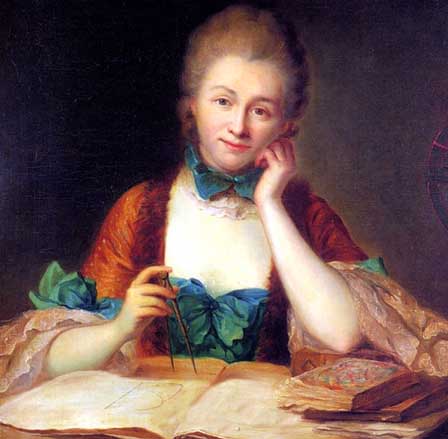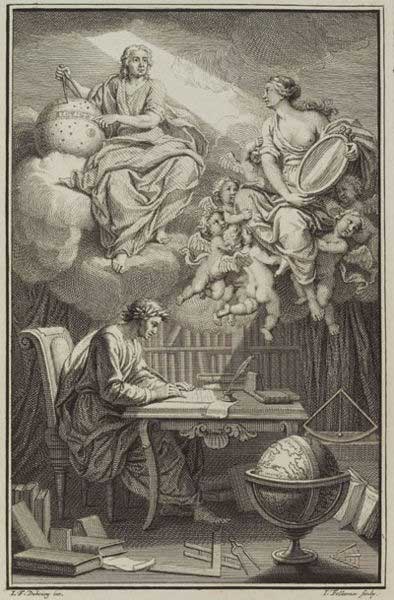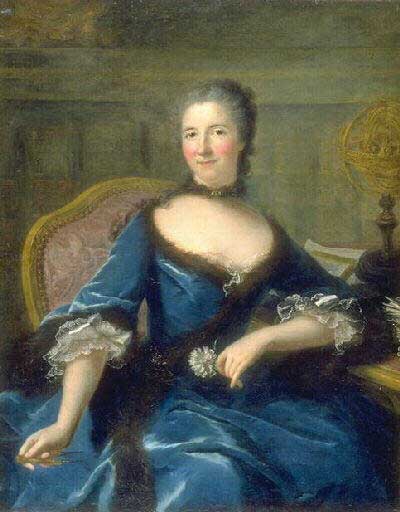.
Émilie du Châtelet

Émilie du Châtelet
Émilie du Châtelet (December 17, 1706 – September 10, 1749) was a French mathematician, physicist, and author
Scientific research and publications
In 1737 she published a paper Dissertation sur la nature et la propagation du feu, based upon her research into the science of fire, that foresaw what is today known as infra-red radiation and the nature of light. Her book Institutions de Physique (“Lessons in Physics”) appeared in 1740; it was presented as a review of new ideas in science and philosophy to be studied by her thirteen-year-old son, but it incorporated and sought to reconcile complex ideas from the leading thinkers of the time. In it she combined the theories of Gottfried Leibniz and the practical observations of Willem 's Gravesande to show that the energy of a moving object is proportional to its mass and the square of its velocity (E ~ mv2), and not directly proportional as had previously been believed by Newton, Voltaire and others. When Einstein produced his famous equation for the energy of matter E = mc2 (where c represents the velocity of light), it accorded neatly with a principle recognised from over 150 years before.
In the year of her death she completed the work regarded as her outstanding achievement: her translation into French, with her own commentary, of Newton’s celebrated Principia Mathematica, including her derivation from its principles of mechanics the notion of conservation of energy. Today this is still the standard translation of the work into French.
Early life
Her father was Louis Nicolas le Tonnelier de Breteuil, the Principal Secretary and Introducer of Ambassadors to Louis XIV, whose position placed him at the center of social activity in the court, and thus gave the family great status. Her mother, Gabrielle Anne de Froulay, was brought up in a convent.
Émilie de Breteuil was a rather awkward child, and so she was given lessons in fencing, riding, and gymnastics in an attempt to improve her coordination. She was remarkably well educated for the time, and by the age of twelve she was fluent in Latin, Italian, Greek and German; she was later to publish translations into French of Greek plays and philosophy. Her family was acquainted with the writer Fontenelle. She received education in mathematics, literature and science. She also liked to dance, was a passable performer on the harpsichord, sang opera, and was an amateur actress.
Marriage and liaisons
On 20 June 1725 she married the Marquis Florent-Claude du Chastellet, and thus became Marquise du Chastellet (the spelling Châtelet was introduced by Voltaire, and has now become standard). The marriage had been an arranged one and the couple had little in common, but the proprieties were observed in accordance with the mores of the time. There were three children and, considering her marital responsibilities fulfilled, Émilie and her husband agreed, while still maintaining one household, to live separate lives. The Marquis was a military man and governor of Semur-en-Auxois in Burgundy, whereas Émilie remained enthralled by the splendour of the royal court. In the upper classes of France at the time, it was acceptable for both the husband and wife to have a lover.
Émilie du Châtelet had three love affairs before she met Voltaire. At the age of twenty-four, she had an affair with the Duc de Richelieu that lasted for a year and a half. The Duc was interested in literature and philosophy, and Châtelet was one of the few women who could converse with him on his own level. She read every book of consequence, attended the theater regularly, and enjoyed intellectual debate. Châtelet expressed an interest in the works of Isaac Newton, and Richelieu encouraged her to take lessons in higher mathematics to better understand his theories. Moreau de Maupertuis, a member of the Academy of Sciences, became Châtelet's tutor in geometry. He was a mathematician, astronomer and physicist, and supported Newton's theories, which were a topic of hot debate at the Academy.
Châtelet invited Voltaire to live in her country house at Cirey-sur-Blaise in Haute-Marne, north-eastern France, and she became his long-time companion (under the eyes of her tolerant husband). There she studied physics and mathematics and published scientific articles and translations. To judge from Voltaire's letters to friends and their commentaries on each other's work, they lived together with great mutual liking and respect.
Châtelet's last affair proved to be fatal. In her early 40s, she had an affair with the poet Jean François de Saint-Lambert and became pregnant. In a letter to a friend she confided her fears that, because of her age, she would not survive her confinement. Châtelet bore the child, but died six days later from an embolism at the age of 42.
Voltaire declared that du Châtelet was "a great man whose only fault was being a woman".[1]

In the frontispiece to their translation of Newton, du Châtelet is depicted as the muse of Voltaire, reflecting Newton's heavenly insights down to Voltaire.
References
- Bodanis, David (2006). Passionate Minds: The Great Enlightenment Love Affair, London: Little Brown. ISBN 0316730858.
- Ehman, Esther (1986)Madame du Chatelet: Leamington Spa: Berg. ISBN 0907582850.
- Mitford, Nancy (1999) Voltaire in Love: New York: Carroll and Graff. ISBN 0786706414.
- Zinsser, Judith (2006) Dame d'Esprit: A Biography of the Marquise du Chatelet: New York: Viking. ISBN 0670038008 online review.
- Zinsser, Judith and Hayes, Julie (eds) (2006) Emelie du Chatelet: Rewriting Enlightenment Philosophy and Science: Oxford: Voltaire Foundation. ISBN 0729408728.
- Ancestors of E=mc2 Online essay from Public Broadcast Service.
- Encylopædia Britannica 1998 edition
- The Guardian 15 May 2006: The scientist that history forgot
- Guardian Unlimited: The scientist whom history forgot
- Voltaire and Emilie from the website of the Château de Cirey, accessed 11 December 2006.
- ^ Review of Passionate Minds: The Great Enlightenment Love Affair by David Bodanis The Guardian 11 June 2006.

Émilie du Châtelet, Marianne Loir, Musée des Beaux-Arts Bordeaux
Links
- Gabrielle Émilie Le Tonnelier de Breteuil Marquise du Châtelet: Biography at the University of St Andrews History of Mathematics archive.
- PhysicsWeb article: Emilie du Châtelet: the genius without a beard
- National Public Radio Morning Edition, November 27, 2006: Passionate Minds
- Women Scientists Today Link to CBC radio interview with author David Bodanis.
Retrieved from "http://en.wikipedia.org/"
All text is available under the terms of the GNU Free Documentation License

